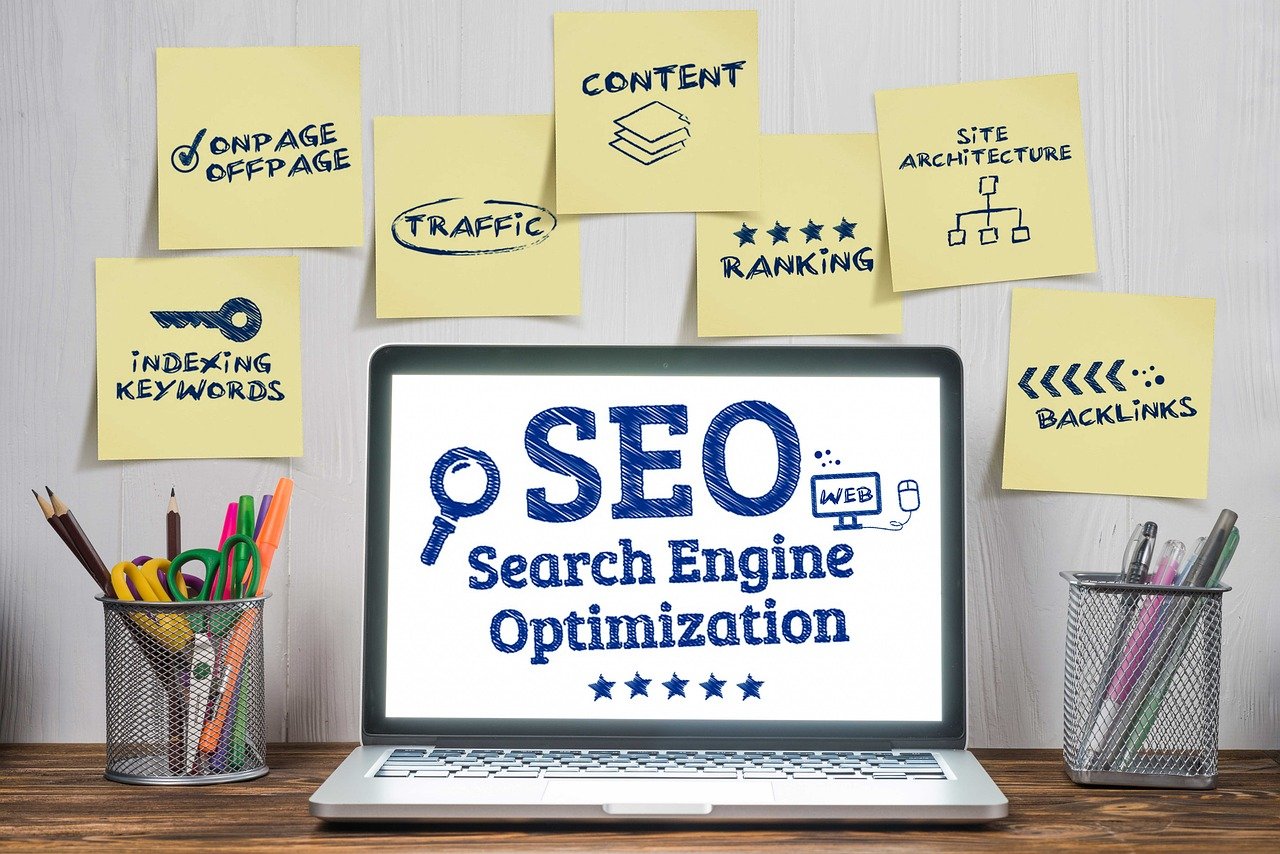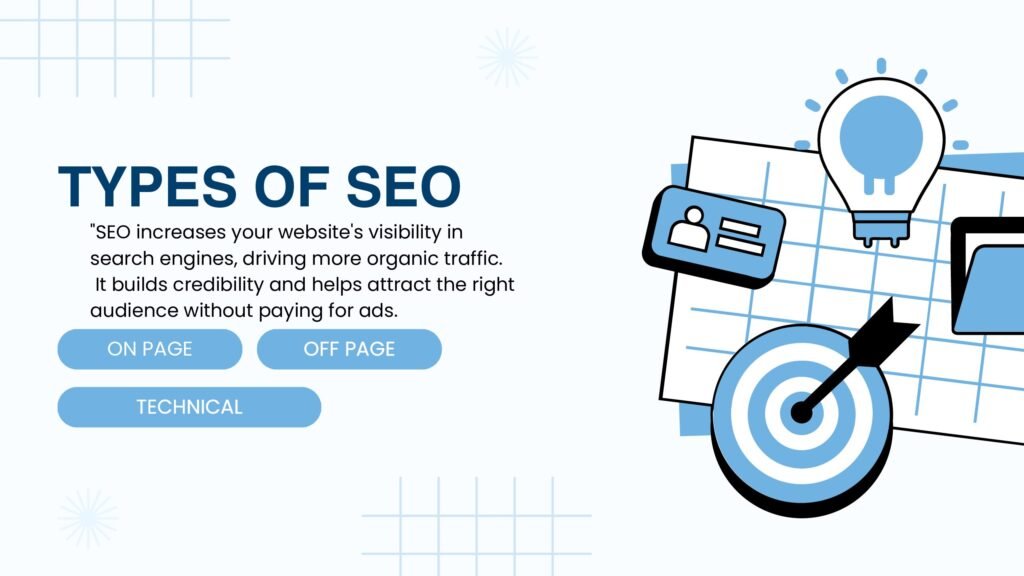Types of SEO: A Complete Guide to Optimizing Your Website for Success"

.
Types of SEO: A Complete Guide to Optimizing Your Website for Success
In today’s digital landscape, mastering SEO (Search Engine Optimization) is crucial for any website aiming to stand out and drive organic traffic. Whether you’re a blogger, business owner, or marketer, understanding the different types of SEO is essential for creating an effective strategy that drives results.
In this guide, we’ll break down the various types of SEO and provide practical tips on how to implement them to optimize your website for success. Let’s dive in!
What is SEO and Why is It Important?
SEO is the process of improving your website’s visibility in search engine results pages (SERPs) by optimizing various elements of your website. The goal is to increase organic traffic (non-paid traffic) and improve your website’s rankings for relevant search queries.
When done correctly, SEO helps your website become more discoverable, attracting users who are interested in what you offer. Whether you’re aiming for higher search rankings, more website visitors, or better conversion rates, SEO is the key to online success.
Types of SEO: The Foundations of Optimization
There are six major types of SEO that businesses and marketers need to consider when optimizing their websites. Let’s explore each one in detail:
1. On-Page SEO: Optimizing Content and Structure for Search Engines
On-Page SEO refers to the strategies you implement directly on your website to make it search engine-friendly. This includes optimizing individual pages, content, and HTML code to improve rankings and visibility.
Key On-Page SEO Factors:
Keyword Optimization: Keywords are the foundation of on-page SEO. Conduct thorough keyword research to identify the most relevant keywords for your content. Use them naturally in your titles, headings, body copy, and image alt text. Tools like Google Keyword Planner or SEMrush can help you find the right keywords.
Title Tags & Meta Descriptions: Title tags should include your target keyword and be compelling enough to encourage users to click. Meta descriptions provide a brief summary of your content and can improve your click-through rate (CTR) if written effectively.
Header Tags (H1, H2, H3): Use header tags to structure your content and make it easier for search engines to understand. Ensure that your primary keyword appears in the H1 tag (main title), and secondary keywords in the H2 and H3 tags.
Internal Linking: Create a robust internal linking structure that connects relevant pages within your site. This improves user navigation and helps search engines index your pages more effectively.
Image Optimization: Use descriptive alt text for images to improve accessibility and boost SEO. Additionally, compress images to reduce load time, which is a critical ranking factor.
Why On-Page SEO Matters: On-page SEO is the foundation of any SEO strategy. By ensuring your website’s content is well-optimized, you give search engines the signals they need to rank your pages higher.
2. Off-Page SEO: Building Trust and Authority Beyond Your Website
Off-Page SEO refers to activities you perform outside of your website that can influence your rankings. The most significant off-page SEO factor is backlinks – links from other websites pointing to your content.
Key Off-Page SEO Strategies:
Backlink Building: High-quality backlinks from authoritative websites act as votes of confidence for your content. Focus on acquiring backlinks from reputable sources in your industry. Guest posting, influencer outreach, and content promotion are effective tactics to build quality backlinks.
Social Media Engagement: While social media signals don’t directly impact rankings, they play a vital role in amplifying your content and driving traffic to your website. Engaging with your audience on platforms like Facebook, Twitter, and Instagram can increase brand awareness and lead to more backlinks.
Brand Mentions: Even unlinked brand mentions on external websites or social media platforms can positively impact SEO. They help increase brand recognition and online authority.
Content Marketing: Creating valuable, shareable content encourages other websites to link to you. Long-form articles, case studies, infographics, and videos are great examples of content that can attract links.
Why Off-Page SEO Matters: Off-page SEO builds your website’s reputation and domain authority. The more high-quality backlinks and mentions your site has, the more trustworthy and authoritative it appears to search engines.
3. Technical SEO: Ensuring Your Website is Search Engine-Friendly
Technical SEO involves optimizing the technical aspects of your website to improve its crawlability, indexing, and user experience. This includes behind-the-scenes elements that impact how search engines understand and rank your site.
Key Technical SEO Elements:
Site Speed Optimization: A slow website can harm user experience and rankings. Tools like Google PageSpeed Insights can help identify issues slowing down your site. Compress images, minimize CSS and JavaScript, and enable browser caching to improve speed.
Mobile-Friendliness: With mobile-first indexing, it’s crucial to ensure your website is responsive and provides a smooth user experience on mobile devices.
XML Sitemap: Submit an XML sitemap to search engines to help them crawl and index your pages more efficiently. An up-to-date sitemap helps search engines discover new content quickly.
Schema Markup: Schema markup is a form of structured data that provides search engines with additional information about your content. Using schema can help your website appear in rich snippets on the search results page.
Crawl Errors: Use Google Search Console to identify and fix crawl errors, broken links, or redirects that can prevent search engines from indexing your pages properly.
Why Technical SEO Matters: Without proper technical SEO, search engines might have trouble crawling and indexing your site, which can negatively impact your rankings. A technically optimized site ensures a smooth user experience and higher chances of ranking well.
4. Local SEO: Optimizing for Location-Based Searches
Local SEO is crucial for businesses targeting customers in specific geographic locations. This type of SEO focuses on optimizing your online presence to appear in local search results.
Key Local SEO Strategies:
Google My Business: Claim and optimize your Google My Business (GMB) profile to appear in local search results and Google Maps. Include accurate business information, photos, and customer reviews.
Local Citations: Ensure your business information is consistent across local directories like Yelp, Yellow Pages, and local Chamber of Commerce websites.
Local Reviews: Positive reviews on platforms like Google and Yelp can improve your local rankings and build trust with potential customers.
Localized Content: Create content that targets local keywords, such as “best pizza in New York” or “top web design services in Los Angeles.”
Why Local SEO Matters: Local SEO helps businesses appear in searches relevant to their geographical location, ensuring they attract customers nearby.
5. E-Commerce SEO: Optimizing Online Stores for Visibility
E-Commerce SEO focuses on optimizing online stores and product pages to improve visibility and drive traffic. This type of SEO is critical for businesses running online shops.
Key E-Commerce SEO Strategies:
Product Page Optimization: Write compelling product descriptions, use high-quality images, and optimize your titles and meta descriptions with relevant keywords.
User Reviews: Allow customers to leave reviews and ratings on product pages. Positive reviews improve your SEO and increase trust with potential buyers.
Mobile Optimization: Ensure your e-commerce site is mobile-friendly, as many users shop on their smartphones.
Why E-Commerce SEO Matters: An optimized e-commerce site ensures higher visibility in search engines, which leads to more traffic and sales.
6. Video SEO: Ranking Your Video Content for Greater Exposure
With the increasing popularity of video content, Video SEO is becoming an essential strategy for improving visibility on platforms like YouTube and Google.
Key Video SEO Strategies:
Optimize Video Titles and Descriptions: Use relevant keywords in your video titles, descriptions, and tags to improve discoverability.
Engagement: Encourage likes, comments, and shares to boost video visibility and rankings.
Video Transcripts: Including transcripts or captions can improve accessibility and help search engines index your video content.
Why Video SEO Matters: Video content is a powerful medium for driving traffic and engaging audiences. Optimizing your videos ensures they rank higher in search results.
Conclusion: Building a Comprehensive SEO Strategy
To achieve long-term success and improve your website’s visibility, it’s crucial to integrate all types of SEO into a comprehensive strategy. On-page, off-page, technical, local, e-commerce, and video SEO all play vital roles in helping your website rank higher in search engine results and drive more traffic.
By implementing these SEO techniques, you’ll not only improve your website’s search rankings but also enhance the user experience, drive organic traffic, and increase conversions. Whether you’re an experienced marketer or just starting, mastering these SEO types will set you on the path to digital success.

